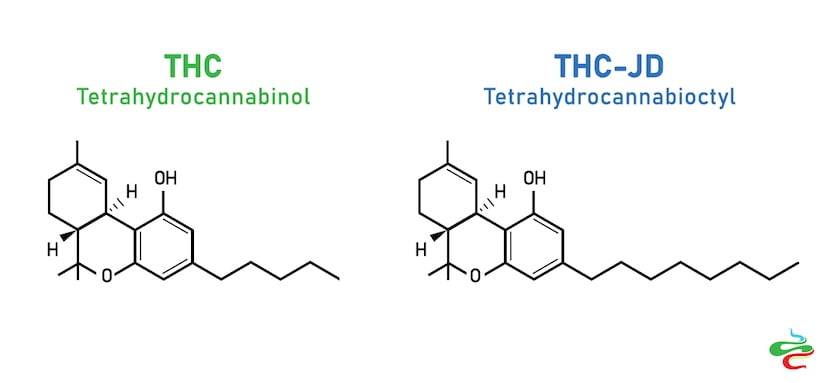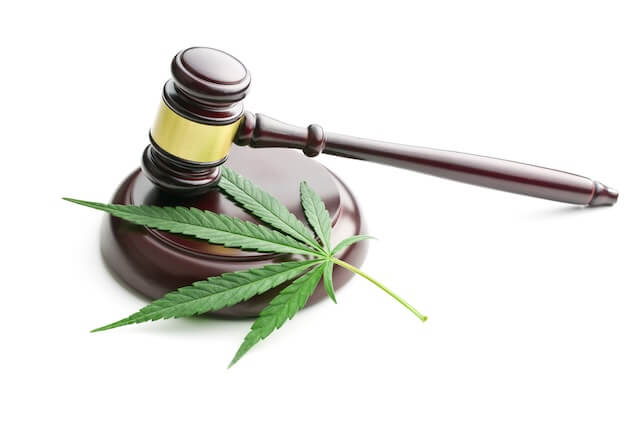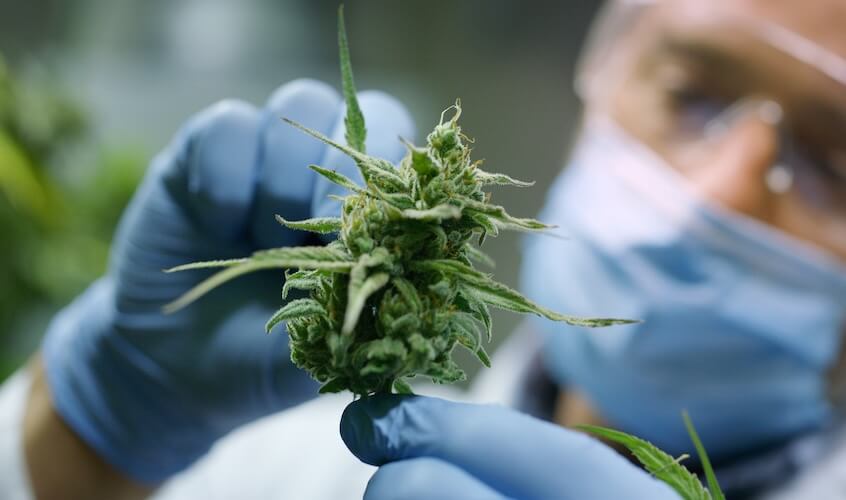The hemp plant contains more than 100 different cannabinoids. Some of these compounds, such as CBD (cannabidiol) and delta-9 THC (delta-9-tetrahydrocannabinol) have been thoroughly investigated and their health benefits are vastly documented. Nevertheless, there are still many cannabinoids that remain undiscovered, which gives the cannabis industry a lot more opportunities for exploration.
One such relatively new cannabinoid is THC-JD, short for tetrahydrocannabioctyl. Claimed to be recently discovered, some cannabis enthusiasts suggest that its chemical structure was identified back in 1941 and was named THC-Octyl or THC-C8. Structurally THC-JD is similar to THC, but the latter has a shorter alkyl chain. It is present in small quantities in the cannabis plant; however, mass production is done in the laboratory from CBD isolate.
Although THC-JD products are readily available online, details about their safety and benefits are still lacking. There are no research studies to go on, hence users must proceed with caution when buying and using THC-JD to manage their health and well-being.
So, today’s article will provide a comprehensive guide about THC-JD and highlight its effects, risks, and legality.
What is THC-JD?
THCJD, also spelt as THCjd, is a cannabinoid that occurs in trace quantities in the cannabis plant. It is among many minor cannabinoids responsible for the entourage effect – the phenomenon where many different cannabis compounds exert a holistic effect to enhance the overall consequences or benefits of a cannabis-infused product.
THC-JD has gained significant popularity among hemp manufacturers mainly because of its heightened and unique psychedelic effects. Preliminary reports suggest that THC-JD is 19 times more intoxicating than THC!
Extraction Process
Since the extraction of THC-JD is expensive and difficult, this compound is synthetically manufactured from available precursors like CBD. This extraction is done through a chemical reaction known as isomerisation.
Firstly, scientists obtain CBD isolate from industrial hemp. The extract then reacts with catalysts that rearrange its molecular composition and convert it into THC-JD. Cannabinoids manufactured using this method are labelled as semi-synthetic.
Structural Significance of THC-JD
As mentioned earlier, THC-JD is a homolog of the popular and abundant cannabinoid, THC. Homologs are compounds with a similar chemical structure but may exhibit different properties.

The main difference between THC-JD and THC is the length of their alkyl (side) chain. THC has a five-carbon chain whereas THC-JD has an eight-carbon side chain; the length of this side chain determines the potency of the cannabinoid. A longer side chain also helps THC-JD to bind differently to endocannabinoid receptors in our body, thus providing exclusive benefits that other hemp-derived cannabinoids do not.
A rather interesting fact about the structure of THC-JD is the claim that it is just the isomer of a compound identified in 1941 called THC-Octyl or delta 8-THC-C8. It is also speculated that THC-JD is the synthetic cannabinoid JWH-138, which was developed for pharmacological studies but was not vigorously experimented with. If these claims are true, then why has this long-known cannabinoid been renamed and reintroduced as THC-JD? One can only guess.
THC-JD Products in the Market
Despite limited research, THC-JD-based products are readily available not only in the United States, but also in certain European countries like Austria, the Netherlands, and the Czech Republic. These products include:
- Vapes
- Cartridges
- Gummies
- Tinctures
- Hash
- Distillate
- Edibles
These products are available in various concentrations and flavours. Moreover, manufacturers usually enrich these products with other THC derivatives like THCP and THCA. Although it is ensured that the THC content remains within the legal limit (0.3% in the US and 1.0% in the Czech Republic), THC-JD is extremely psychoactive and users must exert caution before buying these products.
What are the Effects of THC-JD?
Since there are no research studies on THC-JD, the documented effects are mainly based on user experiences. Moreover, these effects vary depending on the user’s age, sex, dosage, tolerance, method of consumption, and metabolism.
Like other cannabis compounds, THC-JD binds to receptors in the endocannabinoid system, particularly the CB1 and CB2 receptors, which results in various physical and psychological changes. As mentioned, THC-JD has potent psychoactive properties, which some individuals even equate to psychedelic. This means that this compound can alter perception, behaviour, and mood. These effects generally last for about two to four hours.
Moreover, THC-JD can also:
- Enhance sensory perception (i.e., colours, sounds, and sensations seem more vivid and intense)
- Enhance enjoyment in listening to music or creative activities
What are the Possible Benefits of THC-JD?
Although medical and therapeutic research studies on THC-JD are lacking, preliminary evidence and user experiences suggest the following potential benefits of this newly discovered cannabis derivative:
- Relief from Pain: Like CBD and delta-9 THC, THC-JD may possess analgesic properties. This means it can help manage chronic pain and inflammation and relieve the symptoms of diseases such as arthritis.
- Relief from Stress and Anxiety: Users have also reported that THC-JD helps induce relaxation, alleviate symptoms of anxiety, and reduce stress. This makes this synthetic cannabis derivative very appealing for those looking to manage symptoms of mood disorders, PTSD, and depression. However, because of its potency, dosages must be handled cautiously to avoid any drastic effects.
- Improved Appetite: THC-JD has also been reported to stimulate appetite. This can be significantly beneficial for people who have lost their appetite due to an illness or medical treatment and need to boost their food intake.
What are the Side Effects of Consuming THC-JD?

Like all cannabinoids, there are certain side effects associated with consuming this psychoactive substance. These include:
- Increased heart rate
- Dryness of mouth
- Redness of the eyes and skin
- Altered coordination
- Impaired cognition
- Memory lapses
- Paranoia
- Mood disturbances
- Anxiety
Is THC-JD Safe?
Since it is extremely potent, consuming THC-JD might heighten the possibility of getting intoxicated and cognitively impaired. Thus, users must be careful and mindful of how this cannabis derivative can impact their mental functioning, coordination, and decision-making skills.
Secondly, the absence of regulations concerning THC-JD-based products and other lesser cannabinoids presents potential dangers related to the quality, consistency, and accuracy of these products and their labels. This can create difficulties for customers in acquiring trustworthy and safe products.
Furthermore, THC-JD can be detected by drug tests, since it is a homolog of THC. Thus, users who are up for drug testing must be aware of this outcome.
Lastly, since THC-JD is artificially produced, there are risks linked with synthetic or semi-synthetic cannabinoids, such as uncertain chemical makeup, purity fluctuations, and unexpected side effects.
Hence, consumers must exercise caution when purchasing THC-JD products and carefully weigh all potential risks involved. No scientific research has been conducted to evaluate the safety of this particular cannabinoid, so be sure to select reliable vendors that have their products tested by an independent lab.
THC-JD vs. Other Cannabinoids
It is important to know how THC-JD is different from other cannabinoids to make an informed decision before using it for its user-reported health benefits. When comparing popular cannabinoids to THC-JD, THC-JD stands out for its distinct profile, which may be more suitable for users seeking specific effects or those who are sensitive to the potent psychoactive effects of delta-9 THC.
THC-JD vs Delta-9 THC
Delta-9 THC is the predominant form of THC and is well-known for its classic marijuana-like euphoria. The difference between THC-JD and delta-9 THC at the molecular level is the length of the alkyl side chain. As discussed, THC-JD’s bioavailability and potency are significantly increased due to its eight-atom chain.
THC-JD vs Delta-8 THC
THC-JD and delta-8 THC vary in strength and impact. THC-JD, which contains a distinctive alkyl side chain made of eight atoms, provides increased bioavailability and more potent psychoactive effects in comparison to delta-8 THC. This results in a more enjoyable and euphoric experience.
However, since delta-8 THC offers a milder high than THC-JD, it may serve as a better option for individuals who enjoy less potent effects.
THC-JD vs THC-O
There are significant differences in chemical structure and potency between THC-JD and THC-O. THC-JD, having an eight-atom alkyl side chain, provides increased bioavailability and a more evenly distributed euphoric effect.
Moreover, a recent study revealed that THC-O offers limited psychoactive and psychedelic effects. Hence, both cannabinoids offer distinct experiences, with THC-JD being best for individuals looking for a strong, intense high, whereas THC-O is great for users wanting moderate effects.
THC-JD vs THC-P
Both THC-JD and THC-P are powerful cannabinoids; however, they exhibit distinct effects. THC-JD offers increased bioavailability and potency because of its eight-atom alkyl side chain.
THC-P, with its notably extended side chain, is said to have an even higher potency than THC-JD, providing intense and prolonged psychoactive effects.
Although THC-JD provides a strong high, THC-P is ideal for seasoned users looking for the highest potency.
THC-JD: Legality and Availability

THC-JD is considered federally legal if it comes from hemp plants with a maximum of 0.3% delta-9 THC in terms of dry weight. The main reason why THC-JD is legal is because it comes from hemp. At present, THC-JD is not as heavily regulated as delta-9 THC, so it is important to be aware of local regulations before buying or using THC-JD products.
In addition, it is important to remember that the legality of THC-JD can differ by state and region, despite being classified as a hemp derivative under the 2018 Farm Bill. You must also remember that similar to all other minor cannabinoids or semi-synthetic cannabinoids, the legal status of THC-JD may undergo alterations with the introduction of new regulations.
Conclusion: The Future of THC-JD
Being a relatively new substance, THC-JD is currently being studied to gain a better understanding of its impacts, safety characteristics, and potential medical benefits. Sophisticated analytic methods and scientific investigation are essential for revealing the complete range of advantages and potential downsides linked to this cannabinoid.
Scientists are particularly focused on how THC-JD interacts with the endocannabinoid system, its psychoactive effects, and its ability to provide pain relief and anxiety reduction, making it a viable choice for numerous cannabis users seeking alternatives.
So, with regard to safety, due to the absence of clinical research, it is currently impossible to confirm that THC-JD is completely safe. If you are interested in trying it, make sure to buy products from online stores that you are familiar with and pay attention to customer reviews. Choose vendors that have their items verified by a third-party lab and share Certificates of Analysis.
Moreover, always seek advice from a healthcare provider before adding new cannabinoids to your health regimen, and stay updated on the latest research and legal changes.








Article Comments